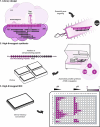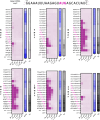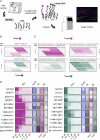High-Throughput Tiling of Essential mRNAs Increases Potency of Antisense Antibiotics
- PMID: 40304263
- PMCID: PMC12302540
- DOI: 10.1002/advs.202504284
High-Throughput Tiling of Essential mRNAs Increases Potency of Antisense Antibiotics
Abstract
Antimicrobial resistance is outpacing drug discovery, creating an urgent need for precision-based strategies to counteract resistant pathogens. Peptide nucleic acid (PNA)-based antisense molecules offer a promising approach by selectively inhibiting essential bacterial mRNAs, but their design rules for optimal efficacy remain incompletely understood. Here, a scalable high-throughput platform is developed for the nanomolar-scale one-shot synthesis of PNAs as carrier peptide conjugates (PPNAs). Parallel synthesis of up to 1,536 PPNAs composed of up to 21 PNA or peptide building blocks enabled systematic, base-by-base analysis of RNA hybridization, mRNA inhibition, and antimicrobial activity across nine essential genes in uropathogenic Escherichia coli. The accuracy and robustness of this high-throughput tiling platform are demonstrated through in-depth analysis of the acpP mRNA and identify potent antisense inhibitors of rpsH, ftsZ, and murA. This approach provides an efficient and scalable route to design and optimize PNA-based antimicrobials, facilitating empirical testing across diverse bacterial targets. By enabling large-scale exploration of the relevant mRNA sequence space, the sequence tiling platform accelerates the discovery of antisense-based antimicrobials, offering a scalable strategy to develop precision therapies against various pathogens and combat resistance.
Keywords: Antisense Antibiotics; Asobiotics; PNA; acpP; ftsZ; mRNA; murA; rpsH.
© 2025 The Author(s). Advanced Science published by Wiley‐VCH GmbH.
Conflict of interest statement
The authors declare no conflict of interest.
Figures






Similar articles
-
Comprehensive analysis of PNA-based antisense antibiotics targeting various essential genes in uropathogenic Escherichia coli.Nucleic Acids Res. 2022 Jun 24;50(11):6435-6452. doi: 10.1093/nar/gkac362. Nucleic Acids Res. 2022. PMID: 35687096 Free PMC article.
-
A systematic review of peptide nucleic acids (PNAs) with antibacterial activities: Efficacy, potential and challenges.Int J Antimicrob Agents. 2024 Mar;63(3):107083. doi: 10.1016/j.ijantimicag.2024.107083. Epub 2024 Jan 5. Int J Antimicrob Agents. 2024. PMID: 38185398
-
Amphiphilic dendrimer-assisted delivery of antisense nucleic acid mimics against E. coli.J Control Release. 2025 Aug 10;384:113850. doi: 10.1016/j.jconrel.2025.113850. Epub 2025 May 23. J Control Release. 2025. PMID: 40414500
-
An Efficient Approach for the Design and Synthesis of Antimicrobial Peptide-Peptide Nucleic Acid Conjugates.Front Chem. 2022 Mar 15;10:843163. doi: 10.3389/fchem.2022.843163. eCollection 2022. Front Chem. 2022. PMID: 35372270 Free PMC article.
-
AI-Driven Antimicrobial Peptide Discovery: Mining and Generation.Acc Chem Res. 2025 Jun 17;58(12):1831-1846. doi: 10.1021/acs.accounts.0c00594. Epub 2025 Jun 3. Acc Chem Res. 2025. PMID: 40459283 Free PMC article. Review.
References
MeSH terms
Substances
Grants and funding
LinkOut - more resources
Full Text Sources
Medical
